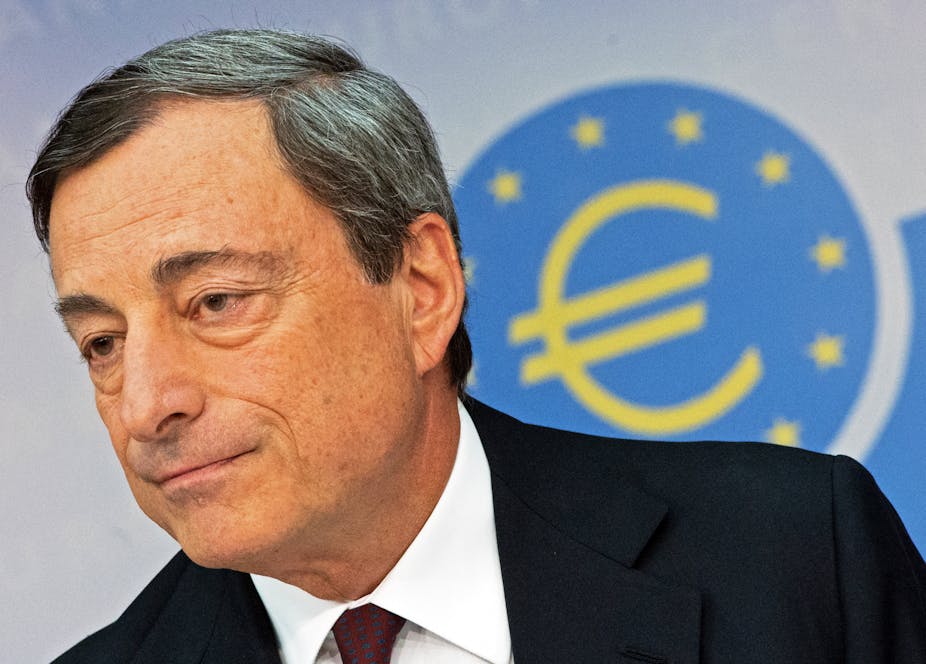Mario Draghi almost single-handedly rescued the Eurozone from disaster two years ago, by pledging to do “whatever it takes to preserve the euro”, so the appeal from the European Central Bank (ECB) chief for more use of fiscal policy to avoid another slump deserves a sympathetic hearing. He is signalling that monetary policy has done all it can. The only option left is to let governments run wider budget deficits.
But in a foretaste of the likely political response, French president François Hollande promptly sacked the two ministers who had spoken out for fiscal relaxation. Hollande was swept into office after making his own stand against austerity, but he and other Eurozone leaders are constitutionally condemned to stay on the path of lower spending and higher taxes, even though France is poised to follow Italy back into recession.
Draghi’s 2012 promise quelled fears of a default by Europe’s PIIGS (Portugal, Ireland, Italy, Greece and Spain), and thereby made it much less likely by reducing their cost of borrowing. But the follow-up strategy, of setting ultra-low interest rates to boost recovery, isn’t working. Banks have been reluctant to lend for new business investment, even when their unlent funds are punished with a negative interest rate. The euro has strengthened against other currencies, when lower interest rates were meant to weaken it and galvanise exports.
This leaves the Eurozone sliding back into recession while other economies, notably the US, post solid output and employment recovery. Forecasts, including the OECD’s, increasingly show the Eurozone’s growth deficiency persisting into the medium term.
The frustration is that the Eurozone should have escaped lightly from the 2008 financial crisis, and bounced back more quickly. It had a smaller and less overstretched financial sector, it avoided the Anglo-American reliance on large capital inflows to finance a wide external trade deficit, and it had spent many years getting its budgets closer to balance in preparation for the monetary union.
Missed opportunity
Draghi’s plea for fiscal activism is effectively an admission that the Americans got it right. When credit dries up, asset values drop, and a self-fulfilling fear of falling profit stops private sector investment, the only way out of the slump is for governments to borrow and spend. Having already run up public debt to rescue troubled banks, insurers and car-makers after the 2008 crash, the US launched a second borrowing spree to fund its “stimulus package”.

Critics (including the Republicans who last year shut down the government by refusing to raise the debt ceiling) believed the money would be wasted, causing an inexorable slide towards insolvency. But five years on, US federal debt is peaking below 80% of GDP, while the Eurozone’s is above 90% of GDP and still rising. Because fiscal stimulus rekindled GDP growth, the US found a sustainable route out of crisis. The Eurozone remains trapped in a cycle of public and private belt-tightening which shrinks demand, pushing production down and debt burdens further up.
Some Europeans argue they could not have copied the US, because it enjoys unique financial privilege. A very low default risk, due to borrowing abroad in its own currency, enables the US federal government to fund large fiscal and external deficits at unusually low rates of interest.
But this also brings America unique disadvantages – notably an overvalued dollar that draws in imports and punishes exporters, and global policing duties that overstretch the defence budget. And the EU, with a bigger unified market and monetary space, had the chance to win similar privilege for the euro. Its self-inflicted relapse into Eurosclerosis may have blown that chance.
Germany holds the reins
The Eurozone’s post-2008 path of fiscal contraction, in contrast to the US expansion, was not a reasoned economic choice but a grim political necessity. By design, the zone has no means of administering coordinated fiscal stimulus. Its member governments are obliged to keep their budget deficits below 3% of GDP, subjected to “excessive deficit procedures” if they overstep this. Public borrowing must be financed by Eurobond issues that remain a domestic responsibility, without backing from the zone’s other governments or the ECB.
While most governments can issue debt in their domestic currency, Eurozone members have lost that aspect of their sovereignty, and must effectively do all their borrowing abroad. They’d be freer if the Eurozone as a whole issued Eurobonds, with proceeds to be drawn by member states needing fiscal stimulus. This option is inevitably vetoed by Germany, which would end up underwriting others’ debts and paying a premium for its own borrowing.
Germany is similarly, and understandably, opposed to suggestions that it should unilaterally deliver fiscal stimulus by announcing tax cuts and spending increases that its own economy doesn’t need. But that economy is now suffering the consequences of the fiscal austerity forced on its neighbours – with growth grinding to a halt in the second quarter and collapsing business confidence hinting at a downturn in the third.
That pessimism may be a temporary result of instability in Ukraine which the EU could do little about. It’s more likely to reflect a lasting design fault which the Eurozone is still struggling to address, forcing members to redouble austerity plans which their own central banker is now telling them to renounce.

